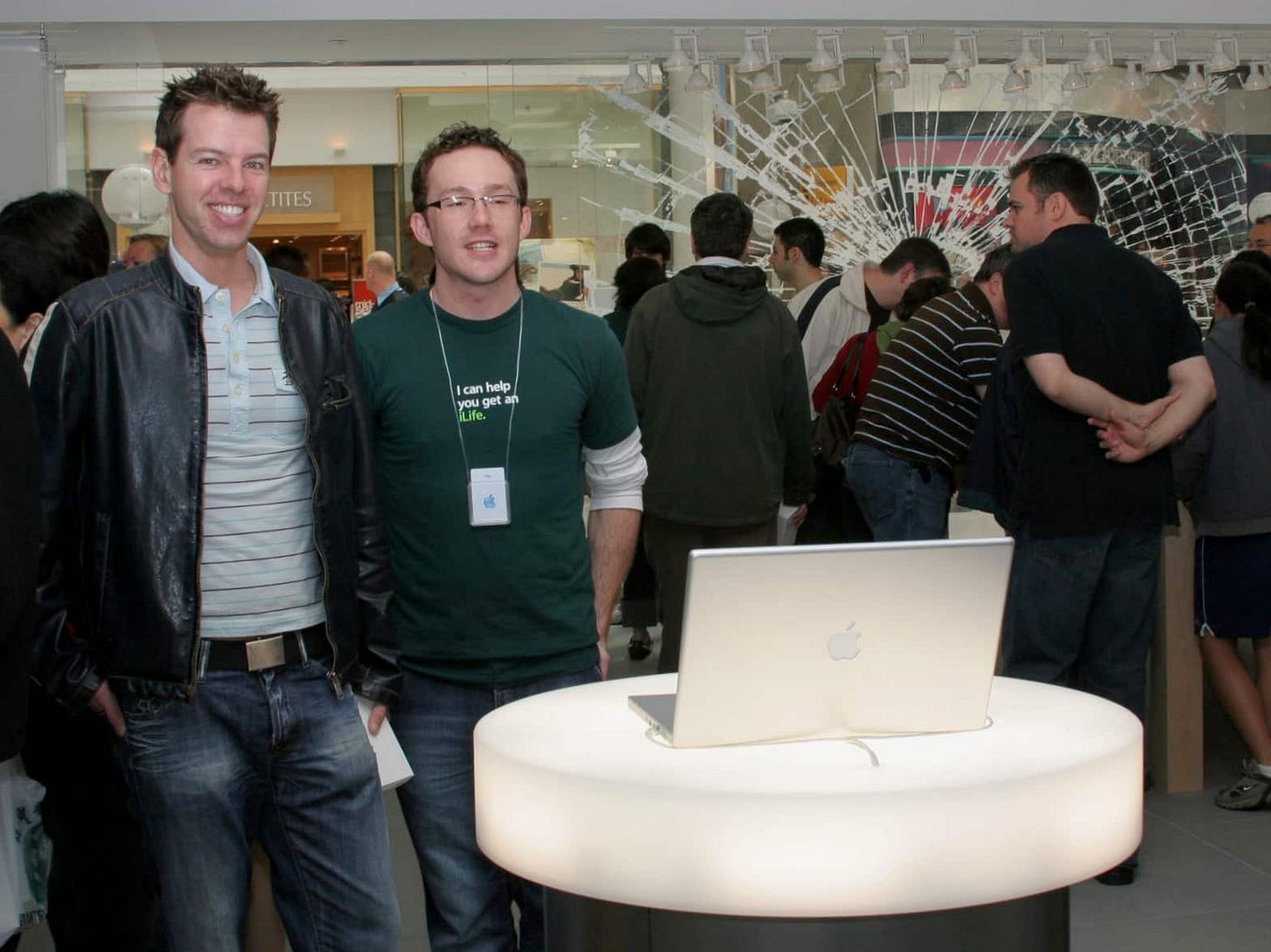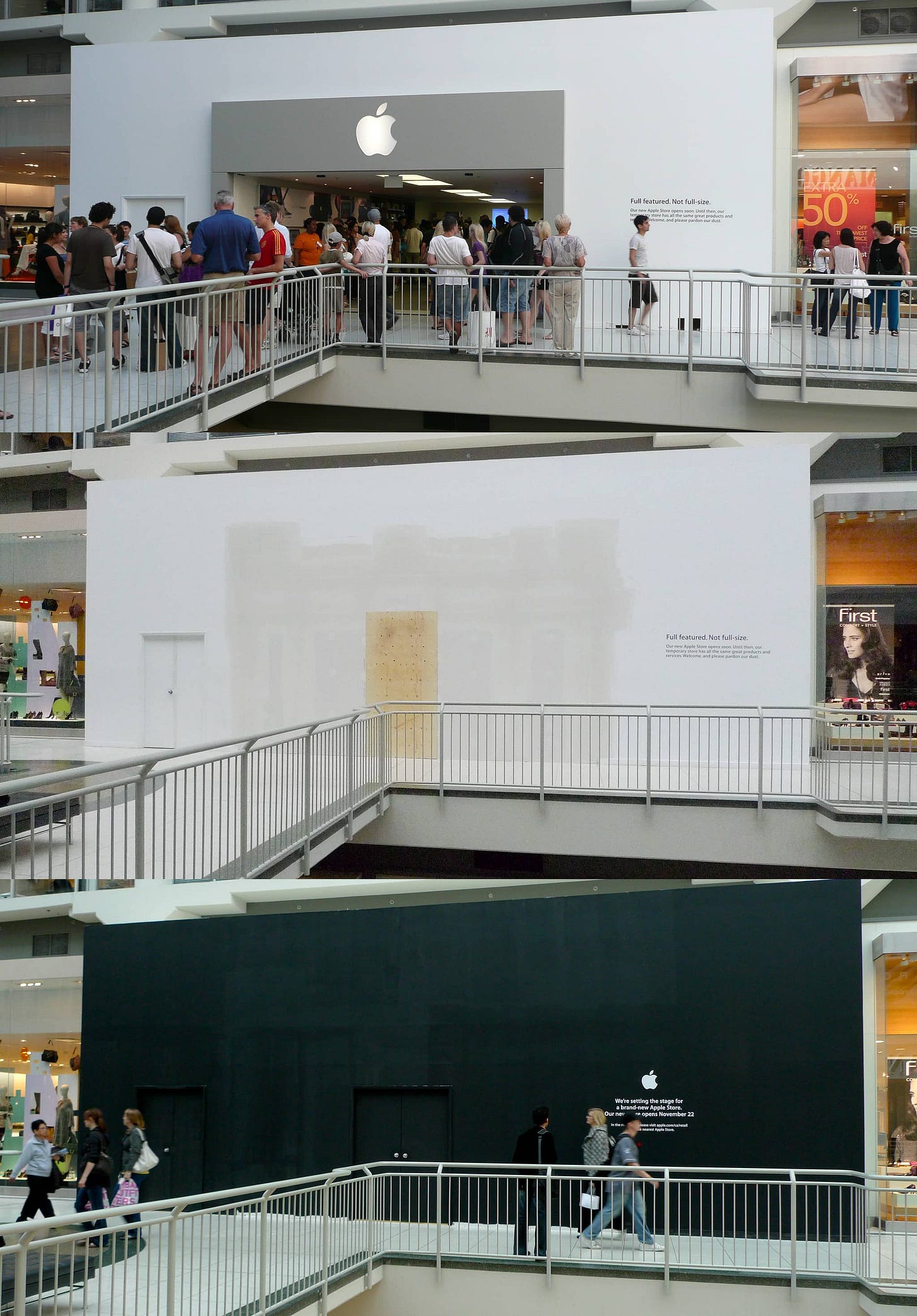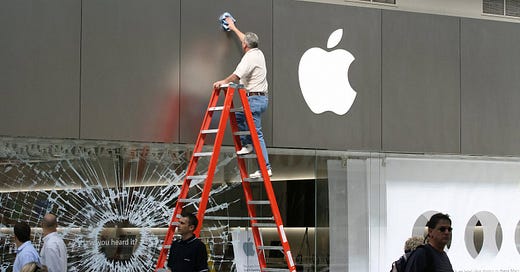Here’s July’s bonus article for paid subscribers. Your support makes Tabletops possible every week. Thank you.
The attention economy for Apple Stores in mid-2006 was tough — all eyes were in Manhattan on The Cube. So when Apple’s second store in Canada opened at the Toronto Eaton Centre on May 6, 2006, it had about two weeks to shine before it was one-upped in grand style. But that didn’t stop Apple from choosing the store as a testbed for new ideas, and it certainly didn’t slow the flow of customers.

Apple announced its arrival on level 3 of the mall with a giant banner ripped from the iPod silhouette campaign. Behind it was the first appearance of “The Studio” in Canada — think Genius Bar, but for creative projects. Other versions of The Studio later appeared at Apple Sherway Gardens and Apple Carrefour Laval.

Unlike most stores at the time, the middle of Apple Eaton Centre was wide and empty save for two round pedestals with a very unusual design. Each pedestal was round, with a thick stainless steel trunk. Up top was an internally-lit white acrylic disc wide enough to highlight one hero product per pedestal. On day one, featured were an original MacBook Pro and an iPod Hi-Fi.

The fixtures were short-lived and extremely rare. So rare, in fact, that I’ve failed to locate another location that opened after Apple Eaton Centre with similar displays. After a bit of digging, I found that the same pedestals were first installed at Apple Ginza sometime in 2004 as iPod listening stations. They later made an appearance at the 2005 opening of Apple Sendai Ichibancho, where they functioned as tiny window displays for a very tiny store.
History tends to repeat itself, and in 2016 Apple displayed the first MacBook Pro with a Touch Bar on cylindrical pedestals at major Apple Stores around the world.
Eaton Centre must’ve been a spectacularly busy store from day one, because just two years and three months after it opened, Apple began a project to completely rebuild the store in place. The unprecedented speed of the replacement store demonstrates just how fast Apple was growing in response to the iPhone and how much Apple Retail design matured in those 27 intervening months.

Apple began by closing the entire store from August 11–15, 2008 while it walled off the entrance and built a mini store within a portion of the normal store area. The reduced footprint allowed demolition and construction of the new space to continue around the clock without turning away customers. Every surface was updated and stainless steel walls were installed.
“Full featured. Not full-sized.” read a message on the construction wall at the entrance. Between 2007 and 2008, Apple experimented with the same playbook to reconstruct 11 more stores in place: Millenia, Somerset, Houston Galleria, Lenox Square, Fashion Valley, South Coast Plaza, The Falls, Glendale Galleria, Valley Fair, Short Hills, and University Village. All 12 mini store projects avoided overlapping iPhone launch dates and were each completed in 3–4 months.

Apple Stores serve far too many customers to make a strategy like this reasonable today, and even in 2008 it was a stretch. Those faux mini stores made actual mini stores seem cavernous. The ceilings were low, the counters were few, and the square footage was even more scarce. The experience looked a bit like shopping in a very nice shipping container.
Few people were inspired to take photos, but thanks to one set of great images hanging around on Flickr, we can still observe the entire project timeline today, from initial operation of the temporary store through its eventual closure ahead of the November 22, 2008 grand reopening:

Apple moved to standalone temporary stores for most of its rebuild projects since Eaton Centre. The architectural precision of contemporary Apple Stores demands longer construction closures and customer needs are greater than the store-within-a-store model allows.
Apple Eaton Centre closed again for a light refresh from November 5–15, 2012, and in December 2019 reopened in a massive new space one level below. The current store is about three times wider than the original 2006 location and has already outlived its total time in service by more than a year.
Thanks to the layout of the Toronto Eaton Centre, Apple’s hero image offers a rare glimpse of the current store and the original location (upper left corner, concealed by a white box) all in one shot.
I’m getting closer to the 1.0 release of Bentos, my new merchandising app. You can still join the TestFlight beta with this secret link and share it with anyone you think might enjoy it. Your feedback is very important to me.
You can view this post and the entire Tabletops archive on the web at any time here.




Once again an excellent and detailed look at something that was designed not to be noticed at all
Thank you for this wonderful look back